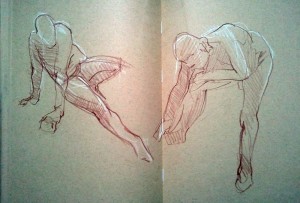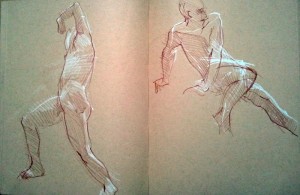I love the energy of fast drawing and the amazing poses but I’m not a expert on how to draw fast. So what follows is is a collection of tips and tricks that I have found helpful in diverse circumstances from drawing horses, circus performers in action and capeoira. Below are a couple from the Wednesday evening sessions at LARA:
Why so fast?
Fast drawing offers opportunities that longer poses just can’t match:
- Unusual and inspiring poses
- High energy drawings
- Spontaneity and flowing drawings
They are a great compliment and refreshing contrast to longer more meticulous drawings.
Before beginning
Chill-out. Doing fast drawings can be pretty hectic and intensive. In this scenario I know I will produce lots of drawings, many will be terrible, some will be ok. I may even like a couple of them. I relish the opportunity to suspend judgement and lose myself in the drawings. At the end of the pose I just turn the page or replace the paper and start again. I’m particularly enjoying this complete contrast to the 4 week long poses that I am doing at the moment.
Pause:Pose
I make a point of pausing before I start drawing, even for really short poses. I use this pause to take in the whole pose: I try and decide what is most important about the pose, and ask myself what do I like most about it? This ensures that I know what aspects of the pose I want to capture – time is limited so I will begin with these, that way even if/when I run out of time I will still have the key elements of that pose. I find that having to make an instant decision about a pose is really useful, I am a natural ditherer when it comes to decision making so an enforced snap judgement gives me access to a valuable immediate/instinctive response.
Materials
I often use vine charcoal, a giant lump which wears down quickly to a chisel shape, giving me the option of flat coverage or fine sharp marks with a twist of my hand. I sometimes rub over charcoal with a tissue, or more often my hand (not recommended) to get more coverage or soften edges and tones. I try to use a smooth paper for fast drawings. I’m a big fan of newsprint for larger drawings but it is non-archival, I love toned paper and have recently started using the Cachet range of sketchbooks. I have the A4 casebound ones, they have a smooth, toned brown paper and they open flat despite being bound.
Method
I tend to use different marks when drawing very quickly, emphasising the energetic quality of my lines by varying the pressure and angle of my charcoal/pencil. This works especially well with more robust drawing tools. I tend to draw as continuously as I can, looking at the model for the majority of the time. I block in areas of tone, pretty scruffily it has to be said, scribbling and smudging a lot. I typically work in two or more colours of charcoal or conté which I use as a light and shadow, working on toned paper provides a ready-made mid tone.
These fabulous fast drawings by E.M. Gist are a great source of inspiration to me. I’d love to see your favourites, too, let me know in the comments below….


Hi Helen,
Superb advice. Totally agree about the necessity of drawing fast and attending some quick pose life sessions. Personally I prefer these sessions as I feel so much more productive and also I have a greater sense of learning.
Thanks, Robin.
Thanks for your comments Robin,
I find doing more drawings allows me to spot repeated mistakes more easily too, a definite help for learning.
I do like to feel productive, I hadn’t realised quite how helpful it is to have that positive feedback until you mentioned it – Thanks.
Helen
I must dig out my old sketch books and look again at the fast drawings I did a few years ago. Not as accomplished as yours Helen but I remember some rare moments when I felt I had achieved that fleeting moment. I always felt physically uncomfortable working in a sketch book as it meant sitting down and trying to manipulate the materials. I dont think I gave enough attention to the type of sketch book I was using. I dont like spiral bound ones and the others had pages which kept on closing at a crucial moment.
Hi Lorraine,
Thanks for your comment – Yes I know what you mean, working in a sketchbook can be awkward and working at a reduced scale can feel very confining too, if you are used to working larger. I find it helpful to clip my sketchbook to a larger board (A2 or larger for an A4 sketchbook) and then rest that on the back of a chair to draw. That arrangement keeps the sketchbook open and allows me to be quite free with my gestures. You could also try a much larger sketchbook, A3 or even A2 which would give you a much larger drawing area, although it can be hard to physically cover the paper as fast as needed with very short poses.